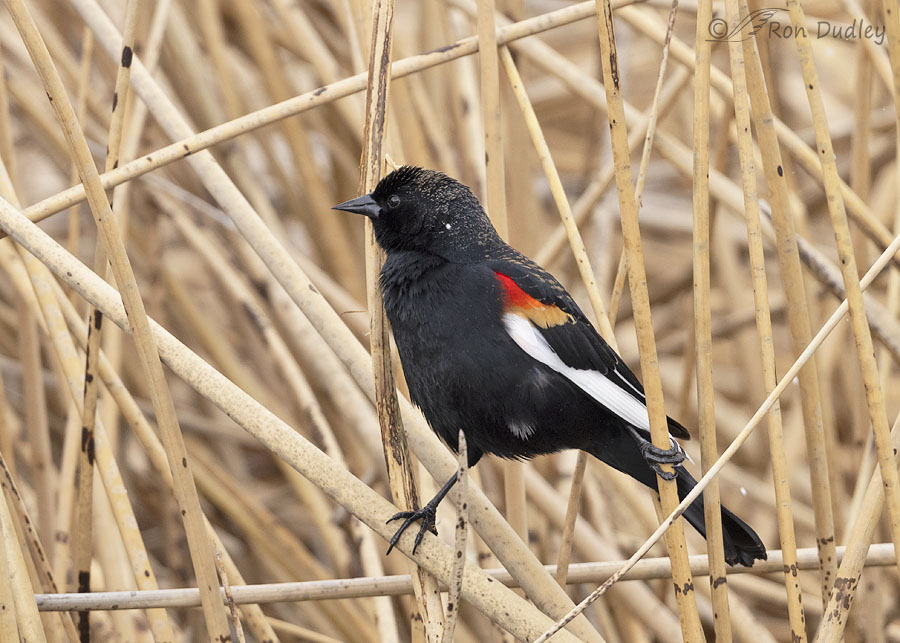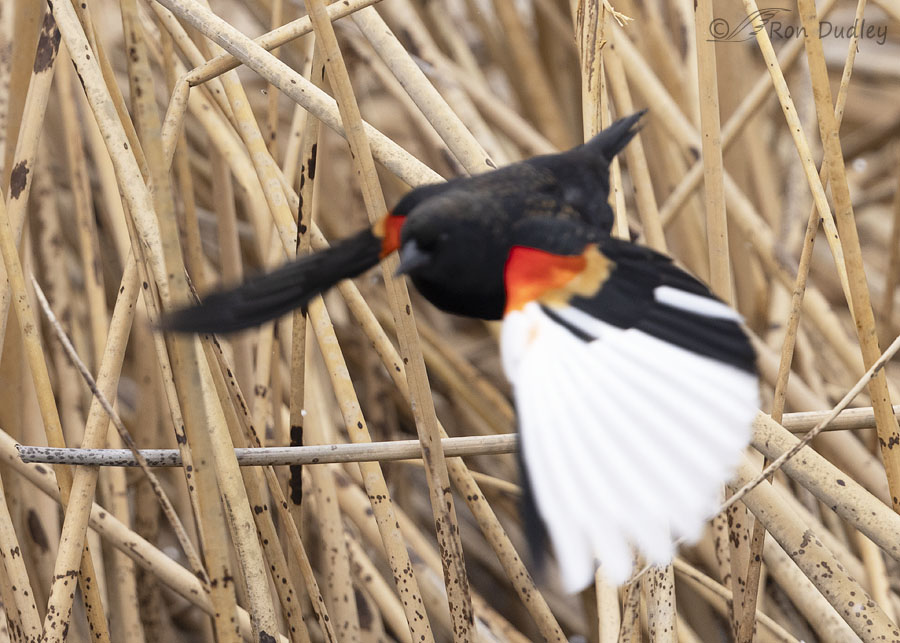Plus, the reappearance of an old avian friend that I was absolutely delighted to see again.
Readers already know that five days ago I had three Evening Grosbeaks, two males and one female, at my backyard feeders. For me Evening Grosbeaks were a lifer species so my excitement was palpable. All three birds hung around together for three days so I had a blast with them.
As always with these grosbeaks, all my photos of them below were taken through my kitchen windows. They simply won’t tolerate me being outside in my yard with them. We’ve had overcast and rainy weather for days so the light was always low. I was using my older Canon 7D Mark II and my “baby lens” and even at ISO 1600 I never had enough shutter speed to freeze the wings of birds in flight.

Then suddenly, two days ago (this photo was taken yesterday), there were three adult males gorging themselves on my mix of hulled sunflower seeds, hulled white millet and roasted peanut pieces, which they really seem to enjoy. I never saw the female again but my bounty of colorful males had increased by 50%.
And things were about to get even better.

Early yesterday morning I suddenly realized that there were five, (count’em, five!), adult males at one of my feeders. You could have knocked me over with… well, a feather. I spent way too much time standing in front of my kitchen window, trying to get all five of them in one shot. I succeeded a few times but it wasn’t easy.

Things were pretty raucous at times. European Starlings seemed to take great delight in…

displacing the grosbeaks from the feeder and pissing me off in the process. Whenever something like this happened, I typically didn’t see any grosbeaks again for at least a half hour. Sometimes much longer.
OK, in my last few blog posts I’ve probably overloaded my readers with photos of Evening Grosbeaks at feeders so let’s move on to something very different.

Two days ago I spotted this leucistic adult male Red-winged Blackbird (along with the two Mourning Doves you see at the bottom of the frame) scrounging fallen seed at the base of my feeder. I was extra excited to see him because he’s an old friend. I spotted him in my yard several times last spring but while he was in my yard I was never able to get photos of him.

However, I did photograph him about six weeks ago at a pond that’s only about a quarter mile from my house. With those white primary feathers in his left wing he’s very easy to recognize.

When he took off I got a (very soft) photo that better shows the extent of the leucism in his left wing. His outermost primary is black but the rest are as white as the driven snow, except for a proximal portion of one of them. And the distal portion of one of his secondaries is also white. In other photos I could tell that the rest of his body, including his right wing and his tail, is covered with normally colored black feathers.
All this makes me wonder. How often do we see individual birds that we’ve seen before, even in previous years, but there’s nothing distinctive about them so we don’t recognize them? Who knows, they may recognize us but we don’t recognize them.
I suspect it might happen more often than we think it does.
Ron


How wonderful. I am convinced (rightly or wrongly) that the same birds come back to our feeders year after year. And that they know us.
This post has made me smile (so widely that my face hurts). Thank you so much.
Glad you enjoyed it that much, EC. And that you let me know.
Very neat!
Thanks, April.
That Redwing certainly does stand out.
The evidence now shows that many migratory birds do return to the same location each year. It’s not true of all birds. Irruptive species like Pine Siskins or Redpolls will be found in different places different years, but many birds do return to the same spot. Not just to the same region but very often to the same specific location. We once had a hummingbird feeder hanging from our deck rail that was well attended by bo Rufous and Anna’s hummingbirds. We keep the feeders up because the Anna’s are here all year (even in cold, freezing weather) but the Rufous are migratory. At some point in winter we moved the feeder to a hook only 2 feet away from the original location. I happened to see the very day that a Rufous male returned. He hovered for several moments at the spot where the feeder had hung when he left in the summer. He hovered around that spot searching. He did find the new location but it was obvious that he expected to find it, not just in our yard, but in the very precise location where it had last been. So, many of the birds returning to your yard each year are the same individuals. It seems very remarkable.
Dan, I knew I’d have to move most of my feeders when lawn-watering began in earnest so I decided to move them today. I just did it. We’ll see how THAT goes.
At least I don’t think I’ll be confusing the grosbeaks. I’m pretty sure they’ve all migrated out of the valley now. I haven’t seen a single grosbeak this morning and I’ve been watching for them.
I had them for five days and I’m grateful for that.
You have enough grosbeaks for a basketball team — fan-freaking-tastic!!! They know who the good human (with the good eats) is and are telling their friends. 🙂
Glad you saw your leucistic pal again. Except for our neighborhood Mallard “quadouple” (yes, all 3 of her drake suitors are back — are ducks kinky?), I’m not sure I’d recognize the same avian visitors. However, I do have two photographs of the same Grey Whale taken a couple years apart by another photographer I used to know. There’s a cool backstory and the barnacle scars make ID pretty easy. They are wall-worthy and up in the dining room.
Marty, I’ve always thought ducks were kinky (especially if you know the structure of their penises) and especially the Mallard drakes. Oh well, if it works for them…
Ron,
Great stuff. If anyone deserves a lifer it is you!
Stephen
Much appreciated, Stephen.
An invasion of Evening Grosbeaks. Really like the two with the Starling hovering. That is cool. I have never seen a leucistic Red-winged Blackbird and we have flocks of hundreds here. A flock of Blackbirds is called a cloud, cluster, or merle.
Thanks, Everett. This is actually my second leucistic red-wing. The other one didn’t have this much white on it.
‘
What a fun post! I’d love to see those guys at my feeder… that is if I had one!
Sounds like you’d better get one, Joanne. Or two. I have four, including my hummingbird feeder.
They know where to go…it pays to have good quality bird food!
“it pays to have good quality bird food!”
I’m convinced it does, Diana. But quality doesn’t come cheap.
Wonderful post. It made my heart light.
Thank you, Pat.
So many interesting things in this post. The most interesting of which is this idea that the repeated sighting of standout birds (like this leucistic Red-winged Blackbird) suggests that we may be seeing specific individual birds – even those that only migrate through an area – revisiting year after year.
We have seasonal sightings of Hooded Orioles in the neighborhood. A pair would nest in out neighbor’s palm and we have been seeing them for the past several years. My wife and I always fancifully referred to them as if they were the same birds each year. Now it would seem that it is very likely that they were the same birds.
“Now it would seem that it is very likely that they were the same birds.”
There’s a very good chance they were, Michael.
Years ago, the mother of a very good friend of mine who lived in Manti, UT, had a Black-billed Magpie that hung around in her yard for many years. She always knew it was the same bird because it only had one leg. I once saw that magpie myself when I visited her (she made wonderful fruit pies and I had my share).
Great shots!
You are so lucky, we haven’t seen an Evening Grosbeak for some time!
I agree about my luck, Dick. I’m so tickled by it I haven’t gone much of anywhere for five days now. But my bad back is paying the price for spending so much time standing in front of my kitchen window..
What fun to have all the Grosbeaks at the feeder – yep, those Starlings are a PITA at times. The Leucistic Red-Winged Blackbird is cool. I also have often wondered how many are reruns when they return to our yard year after year particularly when they start off as a few and increase in numbers over the years.
Judy, a friend of mine, Brian Gatlin, photographed a hybrid Summer x Western Tanager in the same small area six summers in a row. I’ll bet something similar happens often. Here’s a link about Brian’s hybrid tanager.
http://www.azfo.net/gallery/2009/html1/Hybrid_Western_X_Summer_Tanager_RRSP_Gatlin_20090525.html?fbclid=IwZXh0bgNhZW0CMTAAAR1rf18Qp_bV05jOvoJlO28uPnZP5LOyFSNOuHElw6c2jwU0aL12J_LGTAE_aem_ATbtI9-ASxYDUwqEuTN4OiIOPb3tzfgdHlyRYke59amxhcup3RDmxa0lrOMhm1JuGYdRFYM4OoCqFzLz-OaTo3EN